7 Terrifying Horror Manga That Critics Won’t Touch in 2025
Horror manga has evolved from its pioneering days when Kazuo Umezu practically invented the genre by adding paranormal elements to his shojo stories. While Junji Ito has become the defining name within horror manga since 1984, I’ve spent years exploring far beyond these well-known creators, digging into everything from classics to lesser-known gems.
Although The Drifting Classroom is often considered Umezu’s magnum opus, there exists a darker underbelly of good horror manga that pushes boundaries far beyond what mainstream audiences typically encounter. In fact, as someone who considers horror one of my all-time favorite genres, I’ve discovered that the best horror manga often includes works so disturbing that critics actively avoid discussing them. To fans who want to explore the full spectrum of horror manga, it’s important to venture beyond familiar names – which is exactly what we’ll do in this collection of seven titles that are too terrifying even for critics to touch.
Caterpillar by Suehiro Maruo
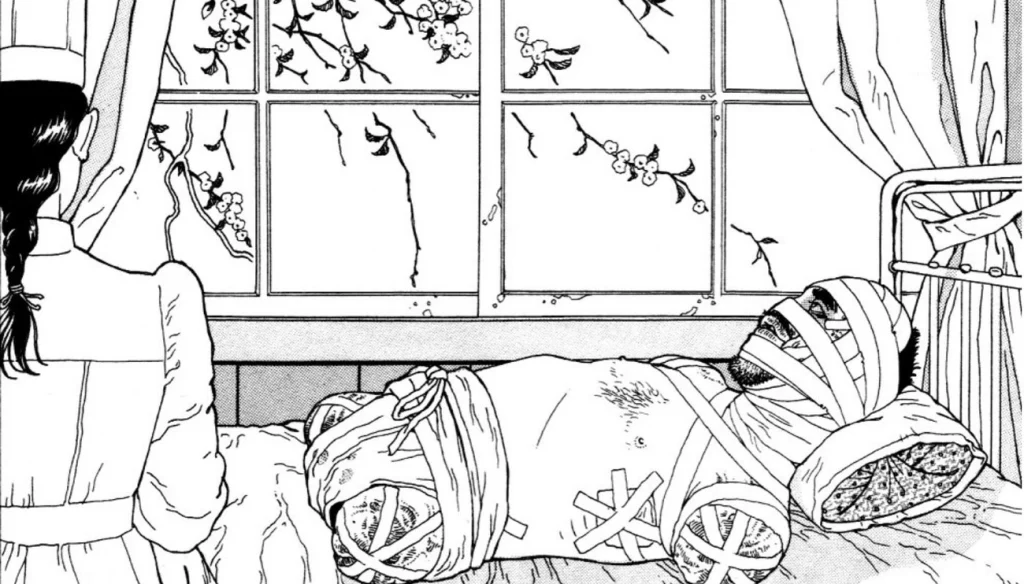
Image Source: Grimoire of Horror
Suehiro Maruo stands as one of the most controversial figures in the horror manga landscape, with Caterpillar representing perhaps his most disturbing work to date. Adapted from Edogawa Rampo’s 1929 short story, this manga pushes the boundaries of what readers can emotionally endure, making it a perfect example of how the best horror manga often exists in spaces critics prefer not to explore.
Caterpillar plot summary
At its core, Caterpillar tells the harrowing tale of Lieutenant Sunaga, who returns to his wife from service in the Russo-Japanese War as a quadriplegic amputee. Completely disfigured and limbless, Sunaga resembles nothing more than a human caterpillar – unable to speak or care for himself in any capacity. Initially, the community celebrates him as a war hero, but this glory quickly fades as people begin moving on with their lives.
Left alone with his wife Tokiko, Sunaga becomes entirely dependent on her care. The couple receives free rent and minimal financial aid, yet as public interest in war veterans diminishes, they find themselves increasingly isolated. Throughout the narrative, Tokiko’s sense of duty gradually dissolves into resentment and contempt as she struggles with the burden of caring for someone barely recognizable as human.
The manga, serialized in Enterbrain’s Comic Beam magazine from May 2009 to August 2009, presents this descent into darkness with unflinching detail. Caterpillar culminates in an inevitable tragedy, making it one of the most profoundly unsettling stories in the horror manga genre.
Why critics avoid Caterpillar
Critics tend to steer clear of Caterpillar for several compelling reasons. First and foremost, the work’s extreme graphic content makes it difficult to discuss in mainstream publications. The original story was controversial even in its time – Rampo’s own wife declared it “filthy” after reading it, and several geisha friends told the author they couldn’t eat after finishing it.
Additionally, the manga’s anti-war sentiments presented challenges historically. During Japan’s militaristic period, the original story faced censorship issues. According to publishers, wartime censorship was so common that magazines often went out with entire passages blacked out. Even today, the manga’s unflinching portrayal of war’s consequences remains politically charged.
Moreover, Maruo’s adaptation fully embraces the ero guro nansensu (erotic grotesque nonsense) movement that Rampo himself helped pioneer. This artistic approach combines erotic and grotesque elements in ways that many critics find too disturbing to analyze thoroughly. The work defies easy categorization as either pornography or legitimate art, placing critics in an uncomfortable position when attempting to evaluate it.
Caterpillar horror elements
Caterpillar achieves its horrific impact through several distinct elements:
- Body horror – The physical transformation of Sunaga from human to “caterpillar” represents one of the most disturbing examples of body horror in manga. His limbless, disfigured state creates immediate visceral discomfort.
- Psychological degradation – The gradual psychological breakdown of both characters forms the emotional core of the horror. As the wife’s resentment grows, her treatment of her husband deteriorates, exploring themes of cruelty born from obligation.
- Sexual horror – Caterpillar incorporates disturbing sexual elements, including the fact that Sunaga’s sexual organs remain functional despite his condition. These scenes create profound unease by juxtaposing desire with disfigurement.
Furthermore, Maruo’s artistic mastery amplifies these horror elements. His intricate artwork creates a mesmerizing yet morbid esthetic that pulls readers deeper into the nightmare. Particularly noteworthy are the dream sequences, including one depicting the wife approached by unknown assailants while lying naked atop mangled corpses that form a pillar of dead soldiers.
Unlike supernatural horror manga, Caterpillar derives its terror from the prison of one’s own body and mind – a concept many readers find far more frightening than any ghost or monster. This psychological approach to horror makes it one of the most genuinely disturbing works in the medium.
Blood on the Tracks by Shuzo Oshimi
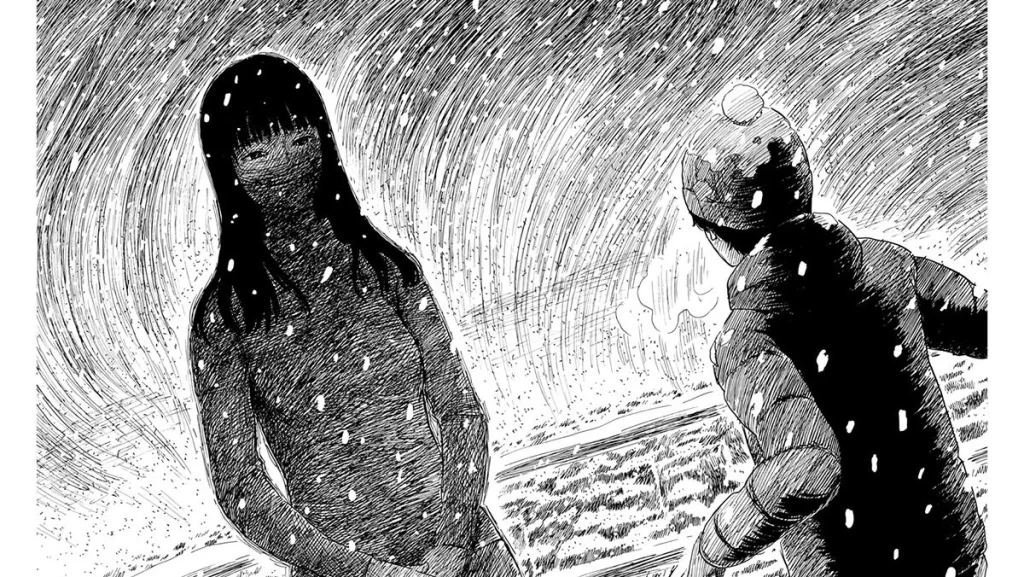
Image Source: Comics Beat
Among the most psychologically disturbing works in modern horror manga, Shuzo Oshimi’s Blood on the Tracks stands out for its uniquely realistic portrayal of maternal obsession gone wrong. First serialized in 2017 and completed in 2023 with 17 volumes, this seinen manga has earned critical acclaim yet remains too disturbing for many critics to thoroughly analyze.
Blood on the Tracks plot summary
Blood on the Tracks (originally titled Chi no Wadachi in Japanese) follows Seiichi Osabe, a shy, withdrawn middle school student living with his seemingly ordinary parents. His mother Seiko initially appears merely overprotective, though her behavior raises occasional concerns among relatives. The story’s catalyst occurs during a family hiking trip when Seiichi’s cousin Shigeru jokingly pushes him near a cliff edge.
Later, at a higher cliff, Seiko approaches her nephew Shigeru and deliberately pushes him off, giving her son a brief smile afterward. Shigeru survives but suffers severe brain damage, leaving him comatose. As the only witness, Seiichi is manipulated by his mother into lying to the police about what happened.
Following this traumatic incident, Seiichi develops a stutter and becomes increasingly isolated. His relationship with his mother grows more disturbing as she sabotages his potential romance with a classmate named Yuiko Fukiishi. Seiko’s behavior escalates from controlling to mentally abusive, even kissing her son on the lips and choking him at one point. Throughout the story, Seiichi slowly uncovers disturbing memories, including a revelation that his mother once attempted to kill him as a child.
Why critics avoid Blood on the Tracks
Blood on the Tracks presents challenges for critics due to several factors:
- Psychological realism – Unlike supernatural horror, this manga portrays a type of terror that’s unsettlingly possible in real life. As one reviewer noted, “a person like Freddy Krueger is imaginary; people like Seiichi’s mom can be real!”
- Maternal taboo – The story confronts the uncomfortable reality that mothers, typically portrayed as protective figures, can be sources of profound damage. Critics often struggle to discuss the “emotional incest” or enmeshment depicted in the story.
- Uncomfortable silences – Oshimi uses deliberate pauses and minimal dialog throughout much of the manga, creating unbearable tension that’s difficult to convey in critical analysis.
The work has garnered significant acclaim nonetheless, winning the 50th Angoulême International Comics Festival’s Prize for a Series in 2023 and being nominated for multiple prestigious awards, including the Tezuka Osamu Cultural Prize in 2024.
Blood on the Tracks horror elements
What makes Blood on the Tracks one of the best horror manga is its uniquely disturbing approach:
- Psychological deterioration – Seiichi’s gradual breakdown is meticulously depicted, especially through his developing speech impediment and dissociative episodes. The manga excels at showing how trauma physically manifests.
- Visual distortion – Oshimi masterfully depicts mental states through art, with reality appearing as “sparse sketches” when Seiichi feels hollowed out. Facial expressions are particularly haunting, with close-ups that communicate profound dread.
- Maternal horror – The story transforms the typically sacred mother-child relationship into something monstrous. Seiko’s expressions cycle between heavenly brightness and overbearing darkness, perfectly capturing the unstable nature of their relationship.
- Everyday terror – Ordinary activities like shopping become horrifying through context. One reviewer observed that “a friendly-looking shopping day can be filled with much dread when you know of the stuff Seiichi’s mom has done.”
- Claustrophobic atmosphere – Readers frequently report feeling trapped alongside Seiichi, experiencing his inability to escape his mother’s influence. The artwork creates a sense of suffocation that mirrors the protagonist’s emotional state.
Essentially, Blood on the Tracks achieves its horror not through supernatural elements or gore but by exploring the catastrophic consequences of familial collapse. The series forces readers to confront the disturbing idea that those closest to us may be capable of causing the most profound damage, creating a horror experience that lingers long after the final page.
Dragon Head by Minetaro Mochizuki
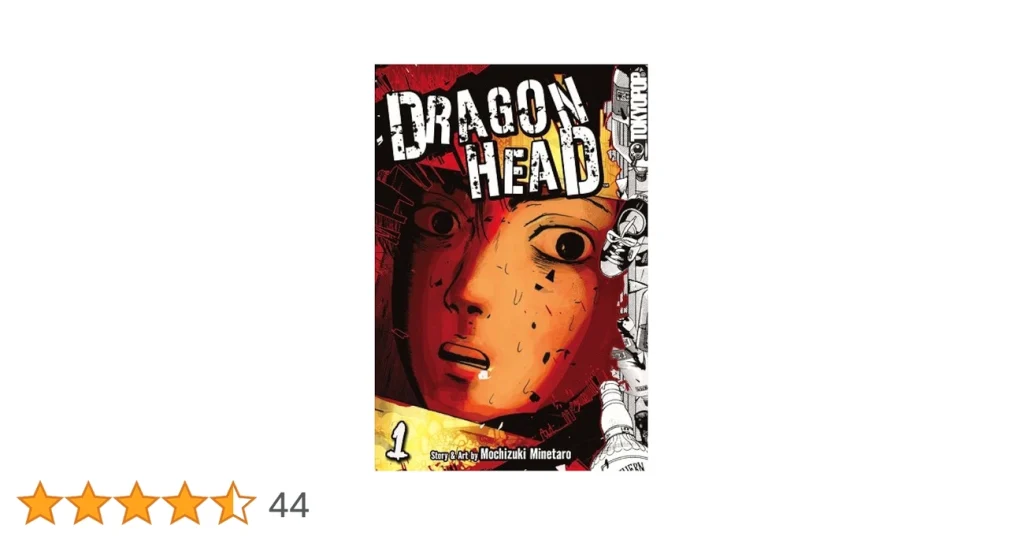
Image Source: Amazon.ca
Minetaro Mochizuki’s Dragon Head represents survival horror at its most visceral, earning its place as a defining work in the post-apocalyptic manga landscape. Published from 1994 to 1999 in Weekly Young Magazine, this 10-volume masterpiece sold over 6.5 million copies and received prestigious recognition, winning both the 21st Kodansha Manga Award in 1997 and the Award for Excellence at the 4th Tezuka Osamu Cultural Prize in 2000.
Dragon Head plot summary
The narrative begins with Teru Aoki, a teenager returning from a school trip when disaster strikes his train inside a mountain tunnel. Upon regaining consciousness, Teru discovers nearly everyone dead except for two fellow students—Nobuo Takahashi, a frequently bullied classmate who quickly descends into paranoia, and Ako Seto, an injured girl who remains unconscious for several days.
As the trio struggles to survive in the tunnel’s claustrophobic darkness, Nobuo’s mental state deteriorates alarmingly. He becomes increasingly violent, even mutilating a teacher’s corpse. After Teru and Ako escape through ventilation shafts—with lava ominously filling the tunnel behind them—they emerge into a world transformed into an ash-covered wasteland.
Their journey eventually leads them to encounter military helicopter pilot Iwada and the unstable Captain Nimura. Through harrowing encounters with dangerous survivors and natural disasters, they gradually piece together what happened: a catastrophic event has essentially destroyed Mount Fuji, leaving a massive crater in its place. The manga concludes with Teru and Ako witnessing foreign soldiers arriving in Tokyo’s ruins as a new volcano erupts, yet still clinging to hope amid overwhelming devastation.
Why critics avoid Dragon Head
Despite its critical acclaim, many reviewers hesitate to fully engage with Dragon Head for several compelling reasons. First, its relentlessly grim portrayal of human behavior under extreme stress creates profound discomfort. Consequently, mainstream publications often struggle to discuss its themes appropriately.
The manga’s claustrophobic atmosphere proves genuinely distressing for many readers. Indeed, as one reviewer noted, “I kept mentally revisiting images from this work long after I finished reading it”. This psychological impact makes critical analysis challenging.
Furthermore, Dragon Head features sequences that seem deliberately drawn out and repetitive, testing readers’ endurance. The work’s only “real sin,” according to IGN, is that “some sequences seem drawn out and even repetitive”—yet this very quality contributes to its suffocating atmosphere.
Additionally, the manga’s unflinching approach to death and decay creates visceral discomfort. Characters must literally move away from the train cars to escape “the accelerated decay that the hyper-hot tunnel has set off”, highlighting Mochizuki’s refusal to sanitize the realities of mass casualty situations.
Dragon Head horror elements
What elevates Dragon Head among good horror manga are its distinctive horror techniques:
- Environmental claustrophobia – Mochizuki masterfully depicts the tunnel’s oppressive darkness, creating what one reviewer called an “oppressively atmospheric” experience.
- Psychological breakdown – The gradual deterioration of Nobuo’s sanity serves as a terrifying reminder of human fragility. His transformation from bullied student to violent aggressor illustrates how quickly social norms collapse under pressure.
- Realistic body horror – Unlike supernatural manga, Dragon Head presents corpses and decomposition with clinical precision. Mochizuki “keeps a strong visual hold on his clammy situation throughout”, making the horror inescapably tangible.
- Existential dread – Beyond immediate survival concerns, the manga explores the profound horror of civilization’s collapse. The characters’ discovery that Mount Fuji has vanished, replaced by a massive crater, encapsulates the incomprehensible scale of their new reality.
Undoubtedly, Mochizuki’s artistic approach heightens these elements. His style has been compared to Charles Burns’s Black Hole and Daniel Clowes’s work—”Pulpy and boldly drawn”, with an obsessive attention to detail that captures “every angle of that derailed train”.
For readers seeking truly unsettling horror manga experiences, Dragon Head remains unmatched in its ability to provoke genuine dread through its fusion of environmental disaster, psychological collapse, and the breakdown of social order.
Shojo Tsubaki by Suehiro Maruo
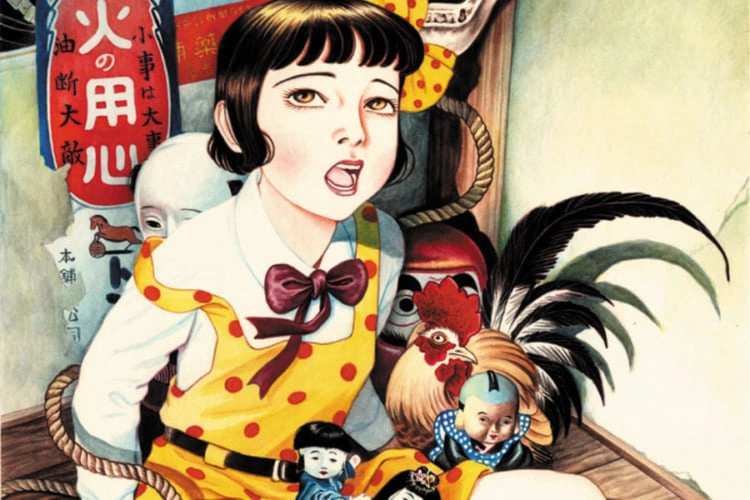
Image Source: Pen
Originally published in 1984, Shojo Tsubaki remains one of the most controversial horror manga ever created, representing Suehiro Maruo’s distinctive contribution to the ero guro (erotic grotesque) subgenre. This disturbing masterpiece has not only shocked readers but also challenged the boundaries of what can be considered acceptable content in sequential art, even within the already extreme landscape of horror manga.
Shojo Tsubaki plot summary
Shojo Tsubaki centers on Midori, a young girl who lives with her bedridden mother after her father abandons them. To support themselves, Midori sells camellia flowers on the streets. After her mother dies—partially eaten by rats—the orphaned Midori seeks help from a man she met while selling flowers. This decision leads her to the Red Cat Circus, a traveling freak show where she’s forced into servitude.
At the circus, Midori endures relentless abuse and sexual assault from the disfigured performers. Her situation changes somewhat with the arrival of Masamitsu, a dwarf magician who takes her as both assistant and lover, using his magical abilities to shield her from the worst abuses of the troupe. However, this relationship itself becomes controlling and abusive.
The narrative follows Midori’s deteriorating mental state as she witnesses Masamitsu murder a rival performer and violently prevent her from pursuing an acting career. After a magical performance goes catastrophically wrong, the police shut down the circus, and Mr. Arashi (the owner) flees with all the money. Masamitsu apologizes to Midori and promises a fresh start, but is murdered by a thief before they can leave together. The story concludes with Midori, abandoned and alone, succumbing to hallucinations and despair.
Why critics avoid Shojo Tsubaki
Critics routinely avoid discussing Shojo Tsubaki for several compelling reasons. First, its extreme content includes graphic depictions of sexual violence that cross boundaries most publications refuse to engage with. The manga was considered so controversial that the 1992 film adaptation by Hiroshi Harada was immediately banned universally upon release.
Even more tellingly, after just two years, Japan’s film censor board Eirin demanded a heavily censored version that removed scenes of sexual assault, animal cruelty, and discriminatory language. From 2004 to 2013, the film remained officially banned in Japan, highlighting the extreme discomfort surrounding this work.
Basically, the thematic combination of child abuse, sexual violence, and psychological torture places Shojo Tsubaki in a category few critics wish to analyze. Simultaneously, the artistic merit and historical significance of the work make it impossible to dismiss entirely, creating an uncomfortable critical paradox.
Shojo Tsubaki horror elements
What elevates Shojo Tsubaki among genuinely disturbing horror manga are its distinctive horror techniques:
- Psychological degradation – The manga meticulously charts Midori’s mental deterioration as she endures trauma after trauma, creating a profound sense of hopelessness.
- Visual juxtaposition – Maruo’s classical, beautiful illustration style directly contrasts with the horrific content, creating a disturbing dissonance that amplifies the horror. His exceptional sequences of “desperate hallucinations, twisting body parts, and limbs crawling with bugs” recall the skittish atmosphere of Japan’s prewar decade.
- Cultural subversion – By taking a character from early Showa-era Kamishibai street theater and injecting “dark magic and nihilistic hedonism” into her story, Maruo creates horror through the corruption of cultural nostalgia.
- Body horror – The circus freaks themselves represent physical deformity as spectacle, while scenes of mutilation and abuse further emphasize the vulnerability of the human body.
Importantly, Shojo Tsubaki serves as a touchstone of the ero guro movement, reconciling violence with strange beauty in ways that continue to influence horror manga today. The work now exists as a sought-after dark classic, with the original manga out of print and preserved by collectors who recognize its significance in the evolution of extreme horror manga.
Panorama of Hell by Hideshi Hino
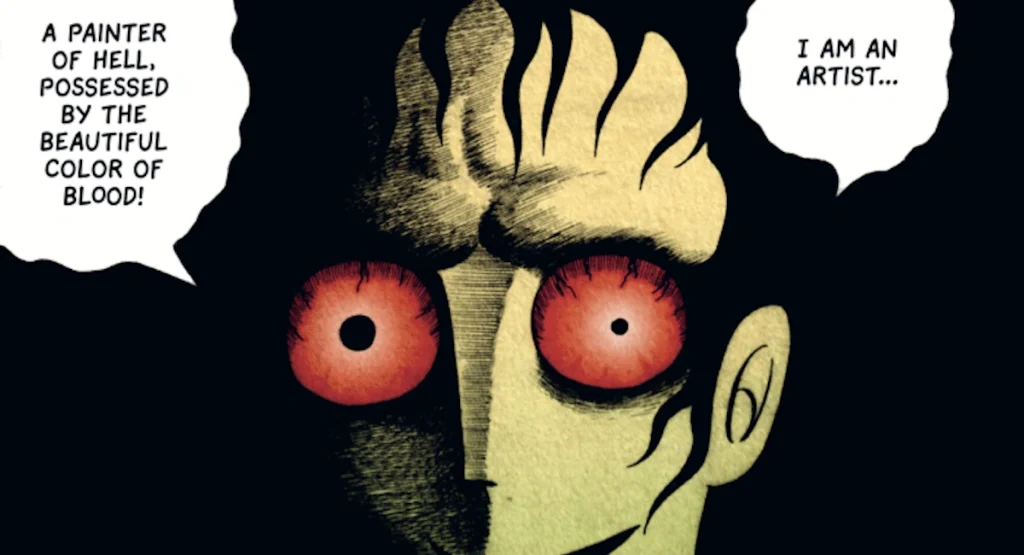
Image Source: Comics Beat
Published in 1984, Panorama of Hell represents one of Hideshi Hino’s most unsettling works in the horror manga landscape. This one-shot masterpiece earned a nomination for Best Album at the 2005 Angoulême International Comics Festival, yet remains largely undiscussed in mainstream criticism due to its profoundly disturbing content and themes.
Panorama of Hell plot summary
Panorama of Hell centers on an unnamed artist who creates hellish paintings using his own blood. Throughout the narrative, he guides readers through his macabre artwork while revealing his unconventional family history. The protagonist recounts stories about his abusive parents who escaped from Manchuria after World War II and his violent childhood that shaped his disturbing worldview.
As the narrative progresses, the artist introduces readers to his bizarre family members—including his grandfather (a yakuza who died vomiting dice), his abusive pig-farmer father with a spider tattoo, and his mentally unstable mother. Each family member’s story reveals a cycle of violence and madness passed through generations.
The artist ultimately works toward completing his magnum opus—a full-scale “Hell on Earth” painting that, within the narrative’s disturbing logic, might actually bring about apocalyptic destruction. The manga concludes with a shocking twist that calls into question whether the artist’s family existed at all or were merely puppets and objects in his delusional mind.
Why critics avoid Panorama of Hell
Critics typically shy away from Panorama of Hell for several compelling reasons. First, its extreme graphic content makes it difficult to discuss in mainstream publications. The manga’s shocking imagery—including self-mutilation, vomiting blood, and numerous depictions of death—creates visceral discomfort that many reviewers prefer to avoid.
Beyond the graphic content, the work’s connections to historical trauma present analytical challenges. As noted by Comics Beat, “Panorama of Hell captures the various terrors underneath Japan’s post-war era” and portrays a narrator who claims to be “the child of the atomic bomb”—representing an entire generation affected by nuclear devastation.
Moreover, the manga defies easy categorization, existing at the intersection of autobiography, horror, and psychological study. Hino reportedly created the work during a period of depression, infusing it with a bleakness that many find too overwhelming to analyze thoroughly.
Panorama of Hell horror elements
What elevates Panorama of Hell among the best horror manga are its distinctive horror techniques:
Psychological horror – The gradual revelation of generational trauma creates a profound sense of unease, with each family member’s story adding to the overwhelming atmosphere of madness.
Visual composition – Hino “drenches most of his pages in black” not merely for shadows but as a compositional choice that creates maximum creepiness through the relationship between positive and negative spaces.
Body horror – The protagonist’s self-mutilation for artistic purposes—cutting himself and drinking acid to vomit blood—creates immediate physical discomfort in readers.
Historical horror – By connecting personal trauma to Japan’s wartime experiences, Hino transforms individual suffering into a broader commentary on collective trauma.
Forty years after its publication, Panorama of Hell remains a defining work in horror manga, creating terror not merely through shocking imagery but by confronting readers with the disturbing reality that the greatest horrors might emerge from our own minds and history.
Brutal: Satsujin Keisatsukan no Kokuhaku
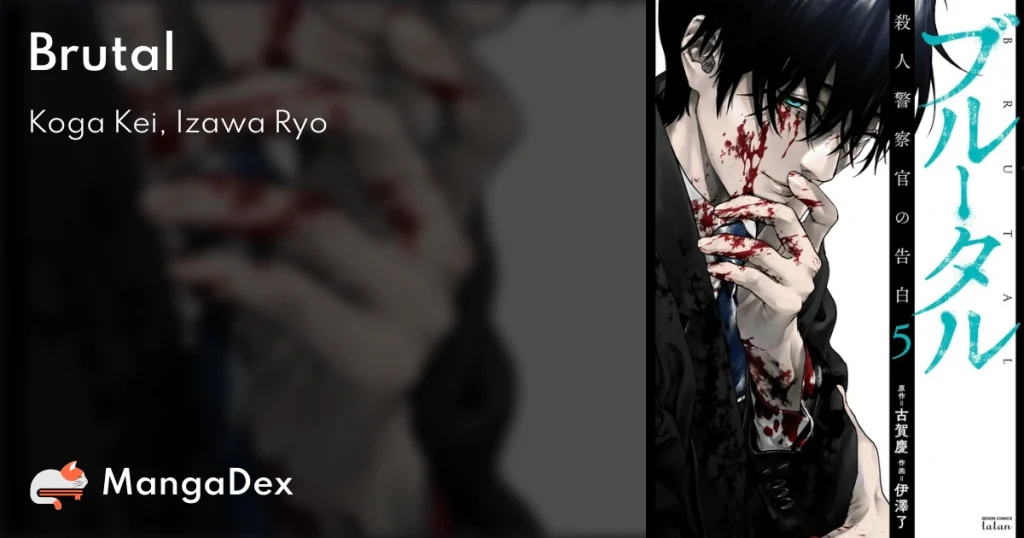
Image Source: MangaDex
Vigilante justice takes a terrifying turn in Brutal: Satsujin Keisatsukan no Kokuhaku (Brutal: Confessions of a Homicide Investigator), a crime thriller manga that began serialization in 2019. This disturbing work explores the boundary between law enforcement and murderous vengeance through its compelling yet horrifying protagonist.
Brutal plot summary
Brutal follows Hiroki Dan, an elite homicide detective whose brilliant career hides a shocking secret—he’s a serial killer responsible for over a hundred murders. As the son of a former police superintendent general, Dan appears destined for professional success. Yet beneath his charismatic exterior lies a vigilante who brutally punishes criminals he believes have escaped proper justice.
Throughout the episodic narrative, Dan methodically tracks and eliminates targets ranging from remorseless child killers to abusive spouses. His first victim shown in the manga is a former murderer who, after serving only 18 years for dismembering children, gleefully publishes a book about his crimes. Dan’s wealthy background and ceramic art hobby provide perfect cover for his gruesome activities, allowing him to continue his “good deeds” while maintaining his professional reputation.
Why critics avoid Brutal
Critics generally steer clear of Brutal because of its extraordinarily graphic content. The manga features explicit torture scenes, including a victim murdered with 666 thrusts from a spiked cross-shaped dildo. Its protagonist embodies moral ambiguity—a law enforcement officer who coldly commits sadistic murders.
The series has remained on hiatus since 2022 because of the author’s health issues, creating additional hesitation among reviewers uncertain of its completion. Additionally, many struggle with how to approach a work that seemingly justifies vigilante justice through elaborate, karma-based executions.
Brutal horror elements
What makes Brutal genuinely terrifying is its psychological depth combined with physical horror:
- Psychological duality: Dan’s seamless transition between respected detective and sadistic killer creates profound unease
- Karmic executions: Each victim dies through means reflecting their crimes—a child abuser dying of hypothermia after being left outdoors in only a diaper
- Cinematic references: Dan incorporates elements from horror films like The Exorcist, including the infamous “spider-walk” while committing murders
As a result, Brutal stands among the most disturbing horror manga specifically because its terrors emerge not from supernatural elements but from the darkest corners of human judgment and retribution.
BIBLIOMANIA by Macchiro Oobaru
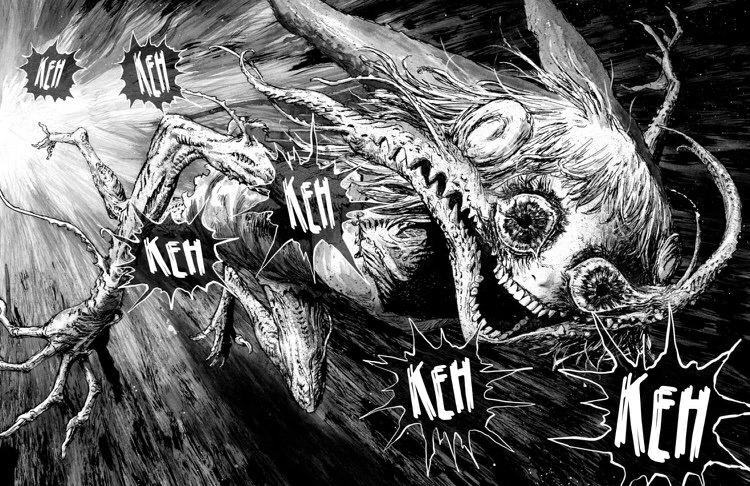
Image Source: Amino Apps
Taking Lewis Carroll’s classic Alice’s Adventures in Wonderland and transforming it into a nightmare of body horror, BIBLIOMANIA stands as one of the most visually striking yet deeply disturbing works in the horror manga genre. This 12-chapter psychological horror created by writer Orval (Oobaru) and illustrator Macchiro presents a haunting exploration of escapism and denial wrapped in gorgeous, intricate artwork.
BIBLIOMANIA plot summary
The narrative centers on Alice, a young girl who awakens in Room 431 of a mysterious manor where the snake-like master named Serpent offers her a bargain: as long as she remains in her room, all her wishes will be granted. Yet if she attempts to leave, her body will progressively rot as she travels through each room. The only escape lies in reaching Room 000, requiring her to pass through hundreds of intervening chambers.
Despite these warnings, Alice embarks on a journey through the manor, encountering strange inhabitants trapped in their own bizarre fantasies. Each room contains a person isolated in their personal delusion. As Alice moves further from her starting point, her body undergoes horrific transformations—sprouting bird feathers, vines, and even a canine snout.
The story ultimately reveals a shocking twist: Alice created the Book of Truth that destroyed humanity during the Second Biblioclastic War. The manor itself exists within this book, making her journey a confrontation with her own apocalyptic legacy.
Why critics avoid BIBLIOMANIA
Critics typically shun discussing BIBLIOMANIA partly because of its extreme body horror elements that become increasingly grotesque. Alice’s physical degradation reaches disturbing heights in Chapter 10, where her fingers elongate unnaturally, her eyes bulge, and her smile stretches inhumanly wide—all while she continues giggling.
Likewise, the lack of an official English release limits mainstream critical engagement, keeping it a cult phenomenon rather than a widely analyzed work. The manga also challenges easy interpretation, with its complex narrative about escapism requiring multiple readings to fully comprehend.
BIBLIOMANIA horror elements
What elevates BIBLIOMANIA among other horror manga are its distinctive elements:
- Psychological deterioration – The story explores how escapism damages the human psyche, a theme increasingly relevant in contemporary society
- Artistic dissonance – Each page features immaculate, beautiful illustrations that clash with the disturbing content, creating an unsettling contrast
- Body transformation – Alice’s cheerful attitude despite her horrific physical degradation creates profound unease
- Environmental dread – The post-apocalyptic setting reveals humanity’s extinction, with Alice ultimately alone in a dead world
The manga’s reading direction itself—Western style, left to right—subtly reinforces its otherness within Japanese manga traditions. Through its exploration of denial and the consequences of obsession, BIBLIOMANIA delivers a horror experience that lingers long after reading.
Comparison Table
| Title | Author | Publication Period | Main Plot Focus | Key Horror Elements | Main Reasons Critics Avoid |
| Caterpillar | Suehiro Maruo | 2009 | War veteran reduced to limbless state, dependent on increasingly resentful wife | Body horror, psychological degradation, sexual horror | Extreme graphic content, anti-war themes, ero guro elements |
| Blood on the Tracks | Shuzo Oshimi | 2017-2023 | Mother’s obsessive relationship with son turns increasingly disturbing | Psychological deterioration, visual distortion, maternal horror | Psychological realism, maternal taboo themes, uncomfortable silences |
| Dragon Head | Minetaro Mochizuki | 1994-1999 | Survivors in tunnel after catastrophic event, facing apocalyptic world | Environmental claustrophobia, psychological breakdown, realistic body horror | Relentlessly grim content, claustrophobic atmosphere, disturbing realism |
| Shojo Tsubaki | Suehiro Maruo | 1984 | Young girl forced into abusive circus life | Psychological degradation, visual juxtaposition, body horror | Extreme content, sexual violence, child abuse themes |
| Panorama of Hell | Hideshi Hino | 1984 | Artist creating hellish paintings with own blood while revealing family history | Psychological horror, body horror, historical trauma | Extreme graphic content, complex historical themes, overwhelming bleakness |
| Brutal | Not mentioned | 2019-2022 | Detective who secretly murders criminals as vigilante | Psychological duality, karmic executions, torture scenes | Extraordinarily graphic content, moral ambiguity, explicit torture |
| BIBLIOMANIA | Macchiro Oobaru | Not mentioned | Girl trapped in manor where her body deteriorates as she explores | Body transformation, psychological deterioration, artistic dissonance | Extreme body horror, complex narrative, limited availability |
Conclusion
Horror manga exists in a realm where artistic brilliance often collides with extreme content, creating works that push far beyond conventional boundaries. Throughout this exploration of seven terrifying titles, we’ve witnessed how creators like Suehiro Maruo, Shuzo Oshimi, and Hideshi Hino craft narratives so disturbing that even seasoned critics hesitate to analyze them thoroughly.
These works share several defining characteristics that make them particularly unsettling. Most notably, they transform familiar human experiences—maternal relationships, physical disability, childhood—into sources of profound horror. Blood on the Tracks turns the sacred mother-son bond into something monstrous, while Caterpillar forces readers to confront war’s devastating consequences through unflinching body horror.
Additionally, many of these manga achieve their terrifying impact through psychological realism rather than supernatural elements. Dragon Head traps readers in suffocating tunnel darkness alongside its protagonists, whereas Brutal presents a protagonist whose seamless transition between respected detective and sadistic killer creates genuine unease. This psychological approach often proves far more disturbing than any ghost or monster could be.
Visual artistry plays a crucial role in these works as well. BIBLIOMANIA juxtaposes beautiful illustrations with disturbing content, creating an unsettling contrast that heightens the horror. Similarly, Maruo’s classical illustration style in Shojo Tsubaki directly contradicts its horrific content, amplifying the reader’s discomfort.
My journey through horror manga’s darkest corners has convinced me that these seven titles represent something beyond conventional horror—they embody artistic visions so extreme and uncompromising that they create a category entirely their own. Though critics may avoid discussing them due to their disturbing content, these works deserve recognition for their unflinching exploration of humanity’s darkest aspects.
Undoubtedly, these manga aren’t for everyone. Nevertheless, for readers seeking horror experiences that truly challenge and disturb, these seven titles offer something that mainstream horror simply cannot—an unforgettable journey into darkness that remains etched in your mind long after you’ve turned the final page.
FAQs
Q1. What are some of the most disturbing horror manga titles? Some of the most disturbing horror manga titles include “Caterpillar” by Suehiro Maruo, “Blood on the Tracks” by Shuzo Oshimi, “Dragon Head” by Minetaro Mochizuki, “Shojo Tsubaki” by Suehiro Maruo, and “Panorama of Hell” by Hideshi Hino. These works are known for their extreme content and psychological horror elements.
Q2. Why do critics often avoid discussing certain horror manga? Critics often avoid discussing certain horror manga due to their extreme graphic content, disturbing themes, and psychological realism. These works can be challenging to analyze in mainstream publications and may push boundaries beyond what’s typically considered acceptable, even within the horror genre.
Q3. What makes these horror manga particularly terrifying? These horror manga are particularly terrifying due to their psychological depth, realistic body horror, and exploration of taboo subjects. They often transform familiar human experiences into sources of profound horror, using visual artistry to create unsettling contrasts between beautiful illustrations and disturbing content.
Q4. Are there any upcoming horror manga releases to look out for? Yes, some upcoming horror manga releases include “Liminal Zone 2” by Junji Ito, “Petshop of Horrors” rerelease, “Ichi the Killer” omnibus, and new volumes of ongoing series like “Gannibal” and “My Name is Shingo”. Several publishers are also bringing lesser-known works to English audiences.
Q5. How has horror manga evolved over the years? Horror manga has evolved from its early days of adding paranormal elements to shojo stories to now encompassing a wide range of subgenres and styles. Modern horror manga often explores psychological terror, body horror, and societal issues, pushing the boundaries of the medium and challenging readers with increasingly complex and disturbing narratives.





